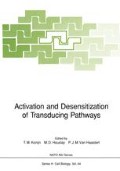Abstract
Myo-inositol is one of nine possible isomers of hexahydroxy cyclohexane in which the 2-hydroxyl is axial to the plane of the 6 membered ring with the remaining hydroxyl groups all being equatorial (Cosgrove, 1980). This configuration ensures that simple derivatives of myo-inositol, such as inositol phosphates, can occur in a variety of isomeric forms e.g. there are 20 possible inositol trisphosphate isomers. Recent studies have uncovered a bewildering complexity of cellular inositol metabolism, much of which is concerned with metabolism of the Ca2+-mobilising second messenger, inositol 1,4,5-trisphosphate (Ins1,4,5P3 3). On the other hand, certain inositol phosphates isomers appear to be involved with the synthesis of inositol polyphosphates such as inositol pentakis- and hexakisphosphate (InsP5 and InsP6) whose function and metabolic relationships to the fast signalling events triggered by receptor stimulated cleavage of phosphatidylinositol 4,5-bisphosphate (PtdIns4,5P2) are not yet understood (see Downes, 1988 and references therein). In addition a novel inositol phospholipid (phosphatidylinositol 3-phosphate, PtdIns3P) has recently been described (Whitman et al, 1988; Stephens et al 1989b) whose synthesis may be regulated by the association of a Ptdlns 3-kinase with activated tyrosine kinases such as the receptor for platelet derived growth factor (PDGF; Whitman et al, 1987).
Access this chapter
Tax calculation will be finalised at checkout
Purchases are for personal use only
Preview
Unable to display preview. Download preview PDF.
References
Ackerman K E, Gish B G, Honchar M P and Sherman W R (1987). Evidence that inositol 1—phosphate in brain of lithium treated rats results mainly from phosphatidylinositol metabolism. Biochem J 242: 517–524.
Balla T, Guillemette G, Baukal A J and Catt K J (1987). Production of inositol 1,3,4,6-tetrakisphosphate during angiotensin II action in bovine adrenal glomerulosa cells. Biochem Biophys Res Commun 148: 199–205.
Cosgrove D J (1980) Inositol phosphates: their chemistry, biochemistry and physiology. Elsevier, Amsterdam.
Coughlin S R, Escobedo J A and Williams L T (1989). Role of phosphatidylinositol kinase in PDGF receptor signal transduction. Science 243: 1191–1194.
Downes C P (1988) Inositol phosphates: a family of signal molecules? Trends Neurosci 11: 336–338
Downes C P, Mussat M C and Michell R H (1982). The inositol trisphosphate phosphomonoesterase of the human erythrocyte membrance. Biochem J 203: 169–177.
Grado C and Ballou C E (1961). Myo-inositol phosphates formed by alkaline hydrolysis of beef brain phosphoinositide. J Biol Chem 235: 54–60.
Irvine R F, Letcher A J, Heslop J P and Berridge M J (1986). The inositol tris/tetrakisphosphate pathway–demonstration of Ins(1,4,5)P3 3-kinase activity in animal tissue. Nature 320: 631–634.
Majerus P W, Connolly T M, Bansal V S, Inhorn R C, Ross T S and Lips D L (1988). Inositol phosphates: synthesis and degradation. J Biol Chem 263: 3051–3054.
Morris A P, Gallacher D P, Irvine R F and Peterson O H (1987). Synergism of inositol trisphosphate and tetrakisphosphate in activating Cat2+-dependent K+ channels. Nature 330: 653–655.
Shears S B, Parry J B, Tang E K Y, irvine R F, Michell R H and Kirk C J (1987). Metabolism of D-myo-inositol 1,3,4,5- tetrakisphosphate by rat liver, including the synthesis of a novel isomer of inositol tetrakisphosphate. Biochem J 246: 139–147.
Stephens L R and Downes C P (1989). Product, precursor relationships amongst inositol polyphosphates. Biochem J submitted.
Stephens L R, Hawkins P T, Barker C and Downes C P (1988a) synthesis of myo-inositol 1,3,4,5,6-pentakisphosphate from inositol phosphates generated by receptor activation. Biochem J 253: 721–733.
Stephens L R, Hawkins P T, Carter N, Chahwala S B, Morris A J, Whetton A D and Downes C P (1988a) L-myo-inositol (1,4,5,6)-tetrakisphosphate is present in both mammalian and avian cells. Biochem J 249: 271–282.
Stephens L R, Hawkins P T and Downes C P (1989a). An analysis of [3H]-myo-inositol trisphosphates found in [3H]-myo-inositol prelabelled avian erythrocytes. Biochem J submitted.
Stephens L, Hawkins P T and Downes C P (1989b). Metabolic and structural evidence for the occurrence of a third species of polyphosphoinositide in cells: D-phosphatidyl-myo-inositol 3-phosphate. Biochem J 259: 267–276.
Stephens L R, Hawkins P T, Morris A J and Downes C P (1988c) L-myo-inositol (1,4,5,6)-tetrakisphosphate (3-hydroxyl) kinase. Biochem J 249: 283–292.
Szwergold B S, Graham R A and Brown T R (1987). Observation of inositol pentakis-and hexakis-phosphates in mammalian tissues by 31P NMR. Biochem Biophys Res Commun 149: 874–881.
Whitman M, Downes C P, Keeler M, Keller T and Cantley L (1988). Phosphatidylinositol kinase makes a novel phospholipid, Type I phosphatidylinositol 3-phosphate. Nature 332: 644–646.
Whitman M, Kaplan D R, Roberts T M and Cantley L (1987). Biochem J 247: 165–174.
Author information
Authors and Affiliations
Editor information
Editors and Affiliations
Rights and permissions
Copyright information
© 1990 Springer-Verlag Berlin Heidelberg
About this paper
Cite this paper
Downes, C.R., Stephens, L.R., Hawkins, P.T. (1990). Heterogeneity Amongst Myo-Inositol Derivatives: Metabolism of Second Messengers and Synthesis of Co-Signals. In: Konijn, T.M., Houslay, M.D., Van Haastert, P.J.M. (eds) Activation and Desensitization of Transducing Pathways. NATO ASI Series, vol 44. Springer, Berlin, Heidelberg. https://doi.org/10.1007/978-3-642-83618-3_9
Download citation
DOI: https://doi.org/10.1007/978-3-642-83618-3_9
Publisher Name: Springer, Berlin, Heidelberg
Print ISBN: 978-3-642-83620-6
Online ISBN: 978-3-642-83618-3
eBook Packages: Springer Book Archive

